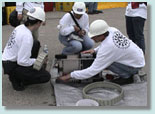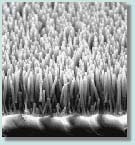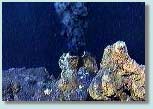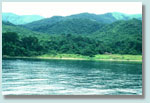| |
 |
 |
 |
|
 |
 |
 |
 |
 |

|
 |
 |
|
|
|
 |
Search-and-Rescue Robots Practice Emergency Response to Simulated Earthquake
|
 |
| |
 An earthquake has just laid waste to a small town. Major roads are impassable, and downed trees have cut power. Worse yet, the local library collapsed during the sudden temblor, trapping a half-dozen patrons. The robots are rushed in to help locate and free the survivors. That was the scenario facing a group of 14 researchers and a crew of search-and-rescue robots as they embarked on an arduous 26-hour field exercise in Lebanon, Indiana, alongside professional emergency response personnel. The exercise was designed to elicit research issues and practical matters that robot developers might overlook or take for granted, such as the special requirements for maneuvering a robot with only a robot's eye view, the need to operate the robot while wearing safety gloves, working while exhausted and designing controls that can be mastered with a week, not months, of training. An earthquake has just laid waste to a small town. Major roads are impassable, and downed trees have cut power. Worse yet, the local library collapsed during the sudden temblor, trapping a half-dozen patrons. The robots are rushed in to help locate and free the survivors. That was the scenario facing a group of 14 researchers and a crew of search-and-rescue robots as they embarked on an arduous 26-hour field exercise in Lebanon, Indiana, alongside professional emergency response personnel. The exercise was designed to elicit research issues and practical matters that robot developers might overlook or take for granted, such as the special requirements for maneuvering a robot with only a robot's eye view, the need to operate the robot while wearing safety gloves, working while exhausted and designing controls that can be mastered with a week, not months, of training.
Image Courtesy: CRASAR, University of South Florida
Read the full story. ... Posted
08/28/03
|
 |
Nanoparticles Change Crystal Structure When They Get Wet, Research Shows
|
 |
| |
 As scientists shrink materials down to the nanometer scale, creating nanodots, nanoparticles, nanorods and nanotubes a few tens of atoms across, they've found puzzling behaviors that fire the imagination and promise unforeseen applications. Now, in a paper in the August 28th issue of Nature, a team of scientists at the University of California, Berkeley, report an unusual effect that could have both good and bad implications for the development of semiconductor devices at the nanometer scale. The discovery, which was supported by the National Science Foundation, also could provide a way to tell whether space rocks came from planets that contain water. As scientists shrink materials down to the nanometer scale, creating nanodots, nanoparticles, nanorods and nanotubes a few tens of atoms across, they've found puzzling behaviors that fire the imagination and promise unforeseen applications. Now, in a paper in the August 28th issue of Nature, a team of scientists at the University of California, Berkeley, report an unusual effect that could have both good and bad implications for the development of semiconductor devices at the nanometer scale. The discovery, which was supported by the National Science Foundation, also could provide a way to tell whether space rocks came from planets that contain water.
Image courtesy: H. Zhang, B. Gilbert, F. Huang, J. Banfield, University of California at Berkeley.
Read the full story. ... Posted
08/27/03
|
 |
NSF Awards New Grants to Study Societal Implications of Nanotechnology
|
 |
| |
 NSF has announced two new
grants, well over $1 million apiece, that greatly expand its
ongoing commitment to study the societal implications of
nanotechnology: the emerging discipline that seeks to
control and manipulate matter on a molecular scale. The
grants will be by far the largest awards the foundation has
devoted to societal implications exclusively. Nanotech has often been hailed as a "transformative"
technology--one that could change the way we live and work as
profoundly as did the microchip or the automobile. "But like any powerful new technology," says NSF Director
Rita Colwell, "nanotech also has the potential for
unintended consequences--which is precisely why we can't
allow the societal implications to be an afterthought." NSF has announced two new
grants, well over $1 million apiece, that greatly expand its
ongoing commitment to study the societal implications of
nanotechnology: the emerging discipline that seeks to
control and manipulate matter on a molecular scale. The
grants will be by far the largest awards the foundation has
devoted to societal implications exclusively. Nanotech has often been hailed as a "transformative"
technology--one that could change the way we live and work as
profoundly as did the microchip or the automobile. "But like any powerful new technology," says NSF Director
Rita Colwell, "nanotech also has the potential for
unintended consequences--which is precisely why we can't
allow the societal implications to be an afterthought."
Image courtesy: Dr. Yicheng Lu, Dr. Sriram Muthukumar, and Dr. Nuri Emanetoglu, Dept. of Electrical and Computer Engineering, Rutgers University
Read the full story. ... Posted
08/25/03
|
 |
Semifinalists Announced in Science and Engineering Visualization Challenge
|
 |
| |
 NSF and the journal Science recently announced 30 semifinalist winners in the "Science and Engineering Visualization Challenge," a new international contest established to recognize outstanding achievements by scientists and engineers in the use of visual media to promote understanding of research results. Contest judges evaluated 300 entries received from participants in the United States and abroad, and selected 10 semifinalists for each of the three contest categories -- photography, illustration and multimedia. The finalists will be announced in the September 12 issue of Science as well as in Science Online. NSF and the journal Science recently announced 30 semifinalist winners in the "Science and Engineering Visualization Challenge," a new international contest established to recognize outstanding achievements by scientists and engineers in the use of visual media to promote understanding of research results. Contest judges evaluated 300 entries received from participants in the United States and abroad, and selected 10 semifinalists for each of the three contest categories -- photography, illustration and multimedia. The finalists will be announced in the September 12 issue of Science as well as in Science Online.
Image courtesy: Curt Suplee/National Science Foundation
Read the full story. ... Posted
08/20/03
|
 |
Genome Sequence for Tomato-Infecting Microbe May Show How Bacteria Adapt to Plant Defenses
|
 |
| |
 Scientists have sequenced the genome of the microbe that causes bacterial speck disease in tomato plants and have reported preliminary information about the roles of the more than 5,500 genes, including clues to how the bacterium infects plants that are constantly trying to defend themselves against pathogens. The bacterium's host-infection mechanism is also similar to that used by many other plant, animal and human pathogens, including a number identified as priority targets for the nation's biodefense efforts. "This model organism will give researchers a leg up on learning about pathogenesis for many other bacteria," said Jane Silverthorne, a program director in NSF's Plant Genome Research Program, which funded the project. Scientists have sequenced the genome of the microbe that causes bacterial speck disease in tomato plants and have reported preliminary information about the roles of the more than 5,500 genes, including clues to how the bacterium infects plants that are constantly trying to defend themselves against pathogens. The bacterium's host-infection mechanism is also similar to that used by many other plant, animal and human pathogens, including a number identified as priority targets for the nation's biodefense efforts. "This model organism will give researchers a leg up on learning about pathogenesis for many other bacteria," said Jane Silverthorne, a program director in NSF's Plant Genome Research Program, which funded the project.
Image courtesy: Thomas A. Zitter, Cornell University, Ithaca, NY
Read the full story. ... Posted
08/19/03
|
 |
Microbe from Depths Takes Life to Hottest Known Limit
|
 |
| |
 It may be small, its habitat harsh, but a newly discovered, single-celled microbe leads the hottest existence known to science. Its discoverers have preliminarily named the roughly micron-wide speck "Strain 121" for the top temperature at which it survives: 121 degrees Celsius, or about 250 degrees Fahrenheit. Previously, the upper known temperature limit for life had been 113° C (235° F). Announcing Strain 121's record-breaking ability to take the heat in the August 15 issue of the journal Science, researchers Derek Lovley and Kazem Kashefi write, "The upper temperature limit for life is a key parameter for delimiting when and where life might have evolved on a hot, early Earth; the depth to which life exists in the Earth's subsurface; and the potential for life in hot, extraterrestrial environments." It may be small, its habitat harsh, but a newly discovered, single-celled microbe leads the hottest existence known to science. Its discoverers have preliminarily named the roughly micron-wide speck "Strain 121" for the top temperature at which it survives: 121 degrees Celsius, or about 250 degrees Fahrenheit. Previously, the upper known temperature limit for life had been 113° C (235° F). Announcing Strain 121's record-breaking ability to take the heat in the August 15 issue of the journal Science, researchers Derek Lovley and Kazem Kashefi write, "The upper temperature limit for life is a key parameter for delimiting when and where life might have evolved on a hot, early Earth; the depth to which life exists in the Earth's subsurface; and the potential for life in hot, extraterrestrial environments."
Image courtesy: Pacific Marine Environmental Laboratory, NOAA
Read the full story. ... Posted
08/14/03
|
 |
Lake Ecosystem Critical to East African Food Supply Is Threatened by Climate Change
|
 |
| |
 In an important new study directly linking climatic warming with the survival of lake organisms, researchers have found multiple lines of evidence showing that increasing air and water temperatures and related factors are shrinking fish and algae populations in a major lake. The lake holds 18 percent of the world’s liquid freshwater and is a critical food source in East Africa. Reporting in the August 14, 2003, issue of the journal Nature, the researchers announce that climate change in the region is harming Lake Tanganyika's ecosystem, decreasing fish stocks by as much as 30 percent over the past 80 years. In an important new study directly linking climatic warming with the survival of lake organisms, researchers have found multiple lines of evidence showing that increasing air and water temperatures and related factors are shrinking fish and algae populations in a major lake. The lake holds 18 percent of the world’s liquid freshwater and is a critical food source in East Africa. Reporting in the August 14, 2003, issue of the journal Nature, the researchers announce that climate change in the region is harming Lake Tanganyika's ecosystem, decreasing fish stocks by as much as 30 percent over the past 80 years.
Image courtesy: Andrew Cohen, University of Arizona at Tucson; National Science Foundation
Read the full story. ... Posted
08/14/03
|
 Top of Page Top of Page
|
|
|
 |
 |
 |
 |
 |
 |
 |
 |
|
 |
 |
 |
|
|

